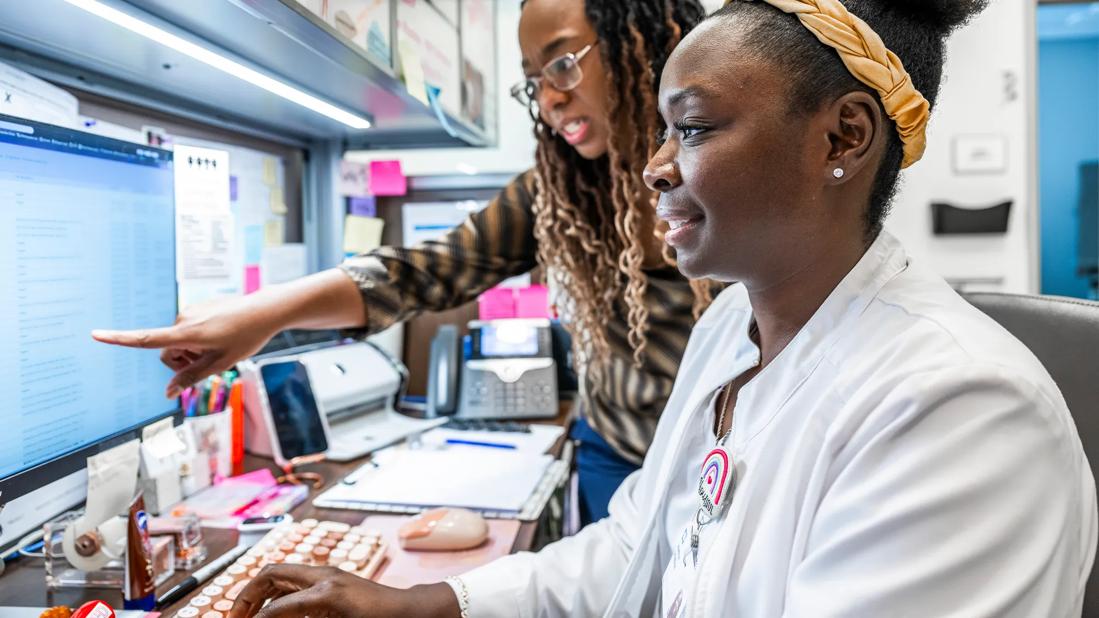Embracing new technology to alleviate documentation burdens

By Nelita Iuppa, DNP, MS, BSN, NEA-BC, RN-BC, FHIMSS, Associate Chief Nursing Officer, Informatics
Advertisement
Cleveland Clinic is a non-profit academic medical center. Advertising on our site helps support our mission. We do not endorse non-Cleveland Clinic products or services. Policy
For decades, medical records were simply a documented transcription of care provided. Today, these invaluable tools serve countless purposes. Through the power of automation, electronic health records (EHRs) have become the cornerstone for information, care coordination and all events and interactions that a patient has within an organization. They are a source of truth for key business operations, including regulatory and financial activities, administrative and scheduling needs, and data and social determinants analysis. They also serve as a data warehouse for other connected and integrated healthcare technologies and medical equipment.
Despite their many benefits, EHRs have become increasingly time consuming for clinicians. For two decades, electronic medical record transformation occurred slowly and methodically. But in the past two years, the scope of these systems has grown quickly and significantly, leaving clinicians to make sense of countless data sources while maintaining accurate, comprehensive patient records. Documentation requirements coupled with business operations responsibilities and quality patient outcome standards have tipped the scales from value to stress. And we need to tip them back.
In 2020, The National Library of Medicine (NLM) funded the 25×5 Symposium to Reduce Documentation Burden on U.S. Clinicians by 75% by 2025. More than 300 decision-makers and influencers from 140 organizations attended, uniting informatics professionals from around the globe to help champion the cause.
Advertisement
As part of this work, the American Nursing Informatics Association, a 25×5 subcommittee, identified six domains of burden for nurses:
Cleveland Clinic’s Office of Nursing Informatics has conducted similar work. Since 2019, we’ve been seeking ways to improve nurse efficiency with the EHR and reduce the amount of time spent documenting.
Through our research, we’ve identified key factors that affect the nurse’s EHR experience:
Addressing these documentation concerns by implementing strategies to overcome them will help organizations pivot back to more positive EHR experiences.
Actions we’ve taken at Cleveland Clinic include identifying how much time, on average, a nurse spends in the EHR per shift. In 2022, a typical inpatient nurse spent approximately 123 minutes per shift actively navigating the electronic record.
We also formed an enterprise-wide multispecialty nursing taskforce to analyze documentation data and provide solutions for reducing overall documentation time. Staff nurses who are active in the EHR daily facilitated this work through three subcommittees that represented our core priorities: nursing care plans, flowsheet documentation volume, and data visualization to review and record. Twenty different tactics were developed to help streamline core priority areas.
Advertisement
And for the first time, in 2022, Cleveland Clinic nursing caregivers participated in the Arch Collaborative KLAS survey for electronic health record satisfaction and efficiency, a national benchmarking tool that compares an organization’s EHR experience with those of other facilities nationwide. Survey results inform organizational strategy and focus areas. To drive future optimization efforts, our results unveiled the following:
Although we still have work to do, we are making progress. Cleveland Clinic nurses scored in the 83rd percentile for overall EHR satisfaction.
New technologies are also emerging quickly to address many of the current clinician documentation burden concerns. These include talk-to-document, predictive modeling support tools, machine-assistive data entry, automated task completion and more.
While addressing the documentation burden issue is imperative, there are other ways to help turn EHR experiences around. Let’s not forget that the EHR is worth its weight in gold. These powerful and dynamic systems offer endless possibilities. Encouraging nursing caregivers to shift their thinking about the EHR from a problem-based mindset to a potential-based mindset is key to changing EHR perceptions from “burden” to “bonus.”
Advertisement
One way we are doing this at Cleveland Clinic is through a documentation excellence program. Documentation excellence looks at how humans choose to interact with technology. Consider the following recommendations:
Nurse leaders and nursing support services
Nurses
Ultimately, it will be the nursing caregiver’s relationship with and mindset about EHR systems that will play the greatest role in improving the nursing EHR experience. This is a journey, not a destination. As long as EHRs are here, work in this space will continue to evolve to complement nursing practice. Nurses must learn to embrace technology as the newest valued member of the care team. Technology is no longer a tool at the bedside; it is a working member of the organization. And like any team member, it needs to be correctly incorporated, communicated with and updated for optimal contribution.
Advertisement
Advertisement

Automating routine medical coding tasks removes unnecessary barriers

Digital “tripwires” detect and respond to malicious activity, boosting cybersecurity maturity

Effective provider training strategies incorporate multi-modal delivery

Thoughtful collaboration, data-driven decisions and effective change management lead to significant savings

A thoughtfully designed program to elevate participants’ leadership potential

Clinical input is integral to technology implementation and adoption strategy

Advancing technology makes informatics expertise essential

Integrating technology is more than product delivery